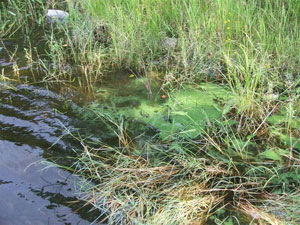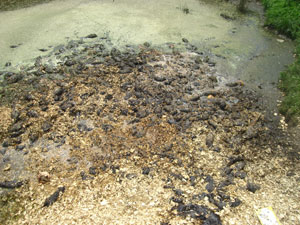|
Cyanobacteria
Toxins – Health 1. The
scientific name for blue green algae is Cyanobacteria
- there
are many species of cyanobacteria, not all are
blue-green in colour. They are an
ancient life form, single celled, with
characteristics of both plant and bacteria (a
bacteria but capable of photosynthesis). Under certain environmental conditions,
Cyanobacteria blooms (single cells massed together)
occur in waters that contain elevated levels of
nutrients (nitrogen and phosphorus). In freshwater
phosphorus is the usual limiting factor; in salt water
nitrogen is the usual limiting factor. Different cyanobacteria species favour
freshwater, some salt water, some a mix of both. Some species of cyanobacteria are capable
of producing toxins, some are not. Species capable of
producing toxins do not always do so. The reason for
this is not well understood. Given the necessary environmental
conditions (i.e. light, nutrient level, temperature,
etc), the cyanobacteria can "bloom" and become
readily visible. In regards to ‘blue green algae’
cyanobacteria, sometimes the bloom appears
as little green clumps suspended throughout the
water table, sometimes it forms into a confluent green
mass on top of the water – the bloom location and
appearance depends on the stage of the ‘bloom’ and
ambient conditions (wind, wave action, light, water
temperature, etc). https://www.gov.ns.ca/nse/water/docs/BlueGreenAlgae.pdf http://www.hc-sc.gc.ca/ewh-semt/pubs/water-eau/cyanobacter-eng.php http://www.gov.ns.ca/nse/water/ 3. The most common
"unnatural" source of excess nitrogen and phosphorus
in water is human activity (animal manure,
fertilizers, septic leakage, erosion, storm water run
off, faulty waste water
treatment facilities, etc). In addition to
excess nutrients from human activities getting into
the water system in this fashion, there would then
also be concern about bacterial (such as hazardous
strains of e-coli), viral and chemical contamination.
http://www.ec.gc.ca/INRE-NWRI/default.asp?lang=En&n=235D11EB-1&offset=7&toc=show
http://www.esajournals.org/doi/abs/10.1890/1051-0761(1998)008%5B0559:NPOSWW%5D2.0.CO;2 4.
There are many species of Cyanobacteria: some species
produce toxins, some apparently not: the key is that
some species are capable of producing toxins that are
harmful to humans, wild mammals, livestock, birds,
dogs etc. The toxin most commonly tested for in
freshwater cyanobacteria blooms is Microcystin LR. http://www.cop.noaa.gov/stressors/extremeevents/hab/habhrca/FreshwaterReport_final_2008.pdf http://www.gov.ns.ca/news/details.asp?id=20070718004 http://www.who.int/water_sanitation_health/diseases/cyanobacteria/en/ http://environment.gov.ab.ca/info/library/7674.pdf http://www.cdc.gov/nceh/hsb/hab/default.htm 5. There are a number
of possible toxins (such as microcystins,
cylindrospermopsins, anatoxins, saxitoxins) which are
harmful. Different cyanobacteria species are linked to
different toxins. (One exception may be the
toxin BMAA, which has been reported to be produced by
> 90% of cyanobacteria species). In freshwater, Microcystin is the type of
toxin most commonly tested for. In order to determine the species of
cyanobacteria and whether a specific cyanobacteria
toxin is present, testing of a properly collected
water sample has to be done at an accredited
lab. Test results provide a "snapshot" of water
quality based on that particular water sample taken at
that particular location and time. Water samples taken
at a different time and / or place could produce
different results. So usually Departments of
Health advise people to avoid all contact
with water that has ‘blue green algae’ in it (as
well as keeping pets away from the water),
including cooking, drinking, skin contact,
swimming, splashing, boating and obviously
ingesting or inhaling (i.e. from aerosolized water
from showers, watering hoses, etc). Toxins are normally contained within the
cyanobacteria cell walls. If the integrity of the cell
wall is breached (such as during a bloom die off, or
by physical or chemical impact), toxins can then be
released into the water body. Some toxins, such as Microcystin, can
persist in the water up to 21 days after a “bloom” has
cleared. Children and those with chronic illnesses
are especially at risk for adverse health effects. Trying
to treat cyanobacteria contaminated water yourself
should never be done - for example,
boiling or using chemicals (such as chlorine and
others) in a mistaken attempt to make the water
safe to use can cause the cyanobacteria cell walls
to break down and release toxins
into the water. As well, accumulation of toxins in water
sourced food, such as fish, can also present a risk to
health. It can be difficult to remove these
toxins from water. http://article.pubs.nrc-cnrc.gc.ca/RPAS/rpv?hm=HInit&afpf=s04-010.pdf&journal=jees&volume=3 http://environment.gov.ab.ca/info/library/7652.pdf 6. Human exposure can
occur through skin contact, inhalation and ingestion:
health effects can vary from mild to severe (skin
irritation, eye irritation, headache, diarrhea,
abdominal pain, nausea & vomiting, fever,
respiratory symptoms, neurological disease, liver
disease, death, etc), depending on the
particular toxin exposure and susceptibility of
the individual. http://www.ncbi.nlm.nih.gov/pubmed/9079227 http://www.hc-sc.gc.ca/ewh-semt/pubs/water-eau/cyanobacter-eng.php http://www.epa.gov/cyano_habs_symposium/monograph.html http://www.who.int/water_sanitation_health/resourcesquality/toxicyanbact/en/ http://www2.epa.gov/nutrient-policy-data/cyanobacterial-harmful-algal-blooms-cyanohabs 7.
Some Health Effects associated with
various Cyanobacteria Toxins: Depending on the degree and type of toxin
exposure, effects can be immediate (acute) or long
term (chronic). It’s possible that extended exposure
to low levels of some toxins may impact health over
time. Microcystins: known liver
toxin, but also can affect the gastrointestinal tract,
the respiratory tract and kidneys. Some studies
suggest a cancer promotion effect (carcinogen). Cylindrospermopsins: can damage
the liver, kidneys, gastrointestinal tract, endocrine
systems, immune system, vascular system and muscles Anatoxins: can interfere
with nerve/muscle function, including causing death by
respiratory failure Saxitoxins: can interfere
with normal nerve function and can be highly
toxic (these are the ones called "paralytic shellfish
poisons") BMAA: (CONTROVERSIAL;
risk not proven)
possibly implicated in neurodegenerative
diseases such as http://www.ncbi.nlm.nih.gov/pmc/articles/PMC3295368/ 8. Research is ongoing
in the scientific community regarding health risk and
cyanobacteria toxins, as there is a growing concern
about the apparent increasing incidence of blue
green algae blooms and health effects related to both
chronic and acute toxin exposures. Increased
water temperatures and more ice free days in our lakes
(i.e. such as occur with global warming) will lower
the threshold at which cyanobacteria blooms will occur
and it will take lesser amounts of excess available
nutrients to trigger these blooms. We need to do
everything we can to reduce the amount of excess
nutrients reaching our waterways. Initial
Version January 2011 Revised
September 2012 |
| Pre 2012.................................... |
| Meanwhile, entire regions of Quebec cottage country have reported dropping real-estate values and plummeting resort business as their lakes get hit with the algae, triggering banner headlines and a mass exodus of sandals and parasols to other parts of the province. (source) |
| Swimming, bathing, showering with the water is not advised. Pets and livestock should not be permitted to swim in, or drink, the water. Direct contact with toxins from algae can cause skin and eye irritation. (source) |
| CBC News - Nova Scotia - No mink farm moratorium,
minister says
Debbie Hall can see the algae foam near her dock on
Lake Fanning. (Courtesy Debbie www.cbc.ca/canada/nova-scotia/story/2009/09/04/ns-mink-rules.html Article link above is pasted below. |
New rules are needed for Nova Scotia's growing mink
industry, said Agriculture Minister John MacDonell, but he
doesn't support a moratorium on new farms.
"The legislation around this is quite old and so we'd like to have a re-look at what we should be doing in the 21st century around these operations," MacDonell told CBC News. Some people in the southwestern part of the province complain that run-off from mink farms is polluting lakes and rivers. Debbie Hall, who lives on Lake Fanning in Carleton,
Yarmouth County, said she can't go in the water because
of green algae she believes is caused from run-off
upstream. "The most excess nutrient level is occurring at the headwaters. That's not natural. That's not normal. What's at the headwaters? Mink farms," said Hall. Hall and others have shown government officials photos of the algae and the situation at one farm, where hundreds of mink carcasses lie in a pool of water, rotting in the sun. Though MacDonell agrees new rules and inspections are needed, he disagrees with critics who want a moratorium on mink farm permits. He said the impact of the farms on the environment must be studied. Mink farming has a long tradition in Nova Scotia. There are now close to 80 farms and up to 1.5 million mink raised each year, according to the local development authority. The industry is worth as much as $100 million a year. The Nova Scotia Tourism Industry is more than 6500
direct businesses supporting almost 40,000 jobs.
In addition, the suppliers to the industry, providing
products to feed, house and entertain our travellers,
contribute payroll and business taxes. Taken from
[http://www.tians.org/] on Sept25-09
|
